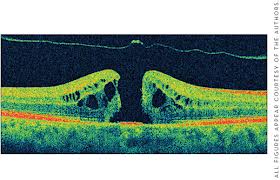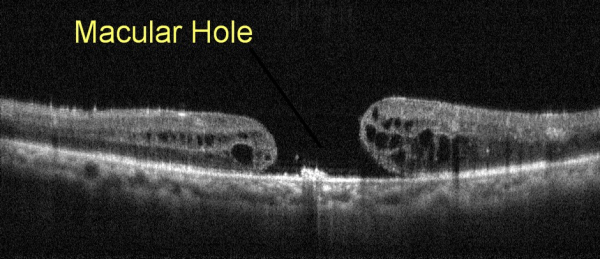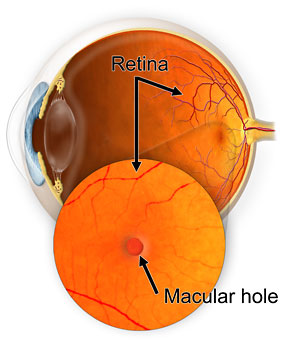Rupture of the macula
Rupture of the macula (macular hole)

Rupture of the macula is a defect in retinal tissue in the region of the yellow spots, which may even affect the entire thickness of the retina from the inner boundary membrane (lamina limitans interna) to the outer layer of photoreceptors.
There are two basic forms of retinal rupture: non traumatic and traumatic rupture of the retina. Non traumatic retinal rupture in most cases is unclear origin but believed to be related to the aging process and occur most often in people aged 60 years and more, frequently in women as a consequence of the degenerative process in the vitreous body of the eye (CV).

At the beginning of the formation of rupture macula, the symptoms are very mild or imperceptible .Vision may be slightly blurred in the central part of the visual field (central scotoma) and distorted images may occur .
These symptoms are usually discovered by accident, when a good eye is closed. Very rarely rupture of macula occurs in both eyes, so many ruptures remain long undetected. Sometimes patient can accurately describe t when the rupture occurred, usually when developing rapidly.
Symptoms for developed rupture of macula:

• Decreased ability to see fine details when looking directly at something, either remotely or in proximity
• Vision is distorted as if looking through a thick fog or wavy glass
• Dark or blind spot in the center of the visual field If there is a rupture of the macula, the patient will not completely lose sight. You will still have peripheral vision and will be able to look sideways with that eye.
In this case the good eye takes over the function of vision, making it possible to perform daily functions.
If the patient notices symptoms of rupture of the macula, it is necessary to immediately report to the ophthalmologist in order to do the review, additional diagnosis and plan surgery in time to stop the spread of rupture and other complications such as retinal detachment. Besides an overview of the pupil dilation, it will be appropriate to do additional diagnostics using the device called OCT (optic coherent tomography).
Treatment of ruptures of the macula Vitrectomy (23G MIVS) is the most effective way solving this problem. The principle of treatment is to surgically remove part of the vitreus which pulls the macula and thus relieve traction. After that, in CV space a mixture of gas and air is injected in the form of bubbles. Bubble pressure the edge of the macular hole, allowing healing.
Therefore, the patient should lie with the face down, to put pressure on the retina all the time. Sometimes it can take a couple of weeks, but this procedure is absolutely necessary in order to achieve the best result after surgery. Gas and air disappear over time and their place is taken by the liquid, and rupture is slowly recovering.
After the surgery, vision is usually recovered back to some extent, depending on the size and duration of the previous rupture. People who have had a rupture of the macula of the eye are more likely (10 per cent) to develop and rupture of the macula of the other eye, at some point in their lives. Therefore, regular reviews are very important in order to detect the problem in time and prevent more damage.
In MILMEDIC macular surgery is performed with lot of success, and Prof Dr. M.Vukosavljević with his team and great experience is a guarantee of high quality treatment.
